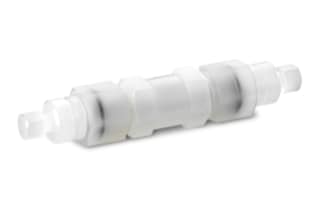
|
Chemistry |
Cation-Exchange |
|
Separation Mode |
Ion-Exchange |
|
Maximum Pressure |
1000 psi (70 Bar) |
|
Particle Shape |
Spherical |
|
Particle Size |
10 µm |
|
Endfitting Type |
Waters |
|
Format |
Column |
|
System |
HPLC |
|
Inner Diameter |
4.6 mm |
|
Length |
50 mm |
|
UNSPSC |
41115709 |
|
Brand |
IC-Pak |
|
Product Type |
Columns |
|
Units per Package |
1 pk |
IC-Pak Cation Column, 10 µm, 4.6 mm x 50 mm, 1/pk
Waters offers an array of products for ion chromatography. IC-Pak resin-based columns allow you to analyze a full range of ions from numerous sample matrices, both simple and complex. They offer an exceptional linear loading range of less than 1.0 ppb to greater than 400 ppm without dilution and without pH limitation on eluent or sample. The flexibility exists for accurate and reproducible anion and cation analyses at all concentration levels.
Liquid chromatography columns have a finite life which is directly related to the care and use they receive. Column life is reduced by contamination from samples and solvents, frequent solvent changeovers, and improper handling and storage. If changes in the peak shape, retention of a particular compound, or resolution between two compounds occurs, take immediate steps to determine the reason for the changes. Until the cause is determined, do not rely on the results of the analyses.
Waters ensures that only the highest quality measures and strictest conditions are used in the manufacturing of our lab equipment, giving you the assurance that the lab equipment will not need to be replaced frequently and will provide you with consistent and accurate results. The IC-Pak Cation Column is manufactured in the cGMP, ISO9001, and ISO13485 certified dedicated Waters facilities where each step of the manufacturing process is carefully monitored, and the strictest conditions are ensured. This enables the production of the IC-Pak Cation Column to offer the tightest specifications in the market to provide consistent results every time.
You will be able to directly shop for lab equipment from our website and also have the option of getting in touch with a member of our global staff to assist you with any queries, concerns, or general guidance regarding lab equipment as needed.
You might also be interested in Waters LCMS Certified Clear Glass 12 x 32 mm Screw Neck Vial, with Cap and Preslit PTFE/Silicone Septum, 2 mL Volume, 100/pk; all Waters LCMS Certified vials are produced following tightly controlled manufacturing processes and handling procedures. They are rigorously tested with mass spectrometers and come packaged with a certificate of analysis showing the reference and vial scan for the manufacturing lot.
How Do I Go About Filtration?
Fill the syringe with approximately 1 mL of air before adding the sample. This will allow air to escape with the sample from the syringe. This "air purge" reduces the amount of fluid retained within the filter device. Fill the syringe with the filtered solution next. Holding the filter device in one hand, twist the filled syringe to the filter device (without using too much force). To begin filtration, apply gentle pressure.